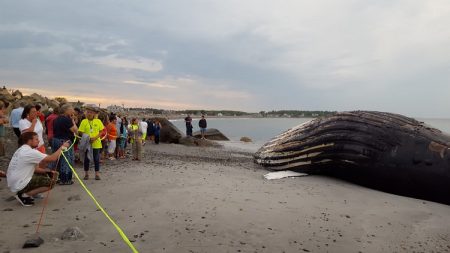You may remember Snowplow, the humpback whale that washed up on the beach in Rye, NH in June 2016. One of our volunteers, Robyn Sealock, shared her story about this event, and we wanted to share it with you.
My Snowplow Story
By Robyn Sealock, Blue Ocean Society volunteer since 2006
The news reported that scores of people were flocking to see the dead humpback that washed up in Rye Harbor. They billed it as a “once-in-a-lifetime opportunity.” I felt saddened that so many people were making a spectacle of this unfortunate dead whale, and I was determined that I wasn’t going to be one of them. Yet, when Blue Ocean Society’s Executive Director Jen Kennedy sent an email plea for volunteers to come down to the site and answer questions, I didn’t hesitate to raise my hand. I would be there because I would have a reason and a purpose to be there, although at the time, I wasn’t quite sure what that would be.
I signed my husband and myself up for a two-hour slot, and after work that day, we donned our Blue Ocean shirts and drove down to Rye Harbor. We were met with an overwhelming number of spectators. They marched up and down the street to the site like ants, lined the rock wall, and crowded the limited shoreline, all to get a good look at this lifeless humpback.
Tuning everything out and remaining focused, we made our way down the beach to meet with Jen, who gave us some details on what had happened and what was happening with the whale Blue Ocean Society had since identified as “Snowplow.” I then did what everyone else was doing. I stared at Snowplow and absorbed what was in front of me—a terribly sad, yet awesome site. Nearly everyone else there was doing the same thing; quietly contemplating what they were seeing. We could hear children asking their parents questions, and not knowing the answers themselves, the parents would say, “Let’s ask that person with the Blue Ocean shirt on.” Before you know it, Frank and I were talking about what kind of whales inhabit our waters, how long humpbacks typically live, and what they eat. Using Snowplow as an example, we pointed out the baleen plates and described how they work. We talked about how Snowplow was identified by the unique markings on its fluke, which is how organizations like Blue Ocean Society identify whales from year to year. Before we knew it, four hours had passed and it was time to go home.
Jen’s email closed with, “While this is a sad event, it’s also a once-in-a-lifetime happening here and I encourage you to go down if you can” I am so grateful I did. Snowplow’s untimely death led her to our shoreline, giving us a great opportunity to teach people about the threats to humpbacks and other marine life in our waters. I hope everyone who visited Snowplow walked away with a newfound appreciation for how organizations like Blue Ocean Society work to protect our marine life through conservation and education. It certainly was my reason and purpose for being there that day.
How to Help:
Many worthy non-profits are in need. However, voiceless animals like Snowplow depend on us to protect them – now, more than ever.
As we close out the year, please consider making us a part of your year-end giving. Your tax-deductible gift will help us educate thousands about Snowplow and threats to humpback whales through a new exhibit in our Blue Ocean Discovery Center, continue to monitor the health of the amazing animals of the Gulf of Maine, reduce threats to their habitat, and educate thousands about how they can protect marine life. With your help, we can save whales like Snowplow in the future.






